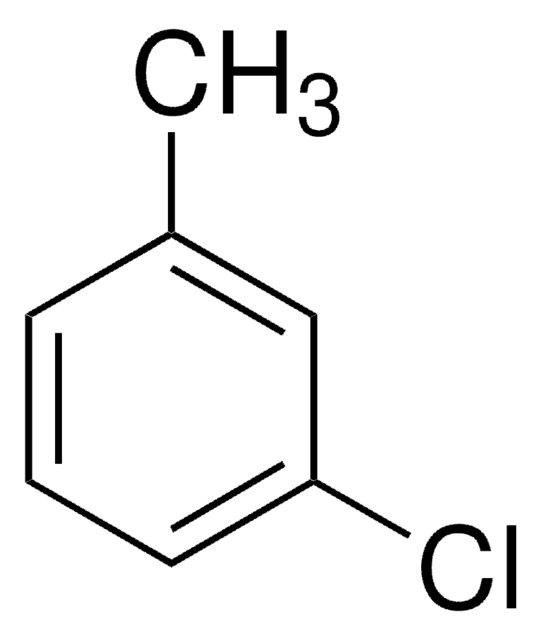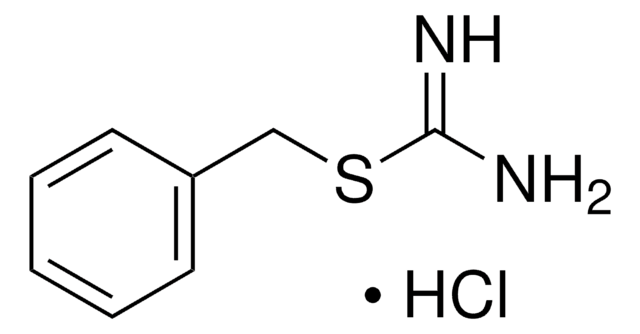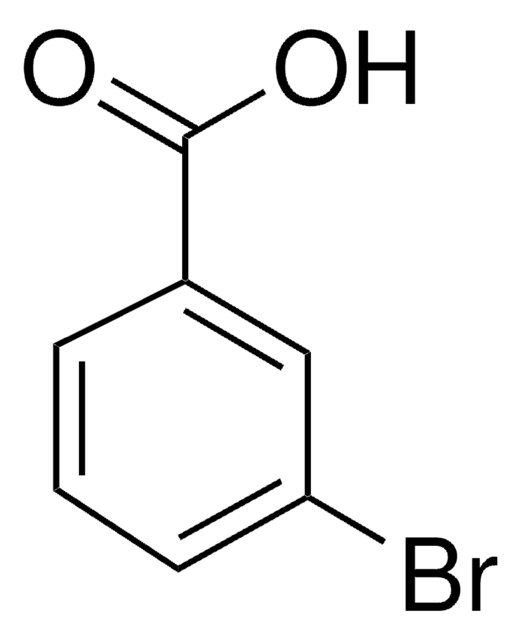C24604
3-Chlorobenzoic acid
ReagentPlus®, ≥99%
Synonym(s):
m-Chlorobenzoic acid
Sign Into View Organizational & Contract Pricing
All Photos(3)
About This Item
Linear Formula:
ClC6H4CO2H
CAS Number:
Molecular Weight:
156.57
Beilstein:
907218
EC Number:
MDL number:
UNSPSC Code:
12352100
PubChem Substance ID:
NACRES:
NA.22
Recommended Products
Quality Level
product line
ReagentPlus®
Assay
≥99%
form
powder
mp
153-157 °C (lit.)
SMILES string
OC(=O)c1cccc(Cl)c1
InChI
1S/C7H5ClO2/c8-6-3-1-2-5(4-6)7(9)10/h1-4H,(H,9,10)
InChI key
LULAYUGMBFYYEX-UHFFFAOYSA-N
Looking for similar products? Visit Product Comparison Guide
Related Categories
Legal Information
ReagentPlus is a registered trademark of Merck KGaA, Darmstadt, Germany
Signal Word
Warning
Hazard Statements
Precautionary Statements
Hazard Classifications
Eye Irrit. 2 - Skin Irrit. 2
Storage Class Code
11 - Combustible Solids
WGK
WGK 3
Personal Protective Equipment
dust mask type N95 (US), Eyeshields, Gloves
Choose from one of the most recent versions:
Certificates of Analysis (COA)
Lot/Batch Number
Don't see the Right Version?
If you require a particular version, you can look up a specific certificate by the Lot or Batch number.
Already Own This Product?
Find documentation for the products that you have recently purchased in the Document Library.
Customers Also Viewed
Timur Deniz et al.
Water research, 38(20), 4524-4534 (2004-11-24)
A mixed microbial culture degraded a mixture of benzoate (863 mg/L), 3-chlorobenzoate (3-CB) (69.7 mg/L), and pyruvate (244 mg/L) under denitrifying conditions in a chemostat. Biodegradation under denitrifying conditions was stable, complete (effluent concentrations below detection limits), and proceeded without
Yong Wang et al.
FEMS microbiology ecology, 78(2), 220-232 (2011-06-16)
Genome-wide scanning of gene expression by microarray techniques was successfully performed on RNA extracted from sterilized soil inoculated with Pseudomonas putida KT2440/pSL1, which contains a chloroaromatic degrading plasmid, in the presence or absence of 3-chlorobenzoic acid (3CB). The genes showing
S Yoshida et al.
Journal of applied microbiology, 106(3), 790-800 (2009-02-05)
To characterize biofilm formation of a chlorobenzoates (CBs) degrading bacterium, Burkholderia sp. NK8, with another bacterial species, and the biodegradation activity against CBs in the mixed-species biofilm. Burkholderia sp. NK8 was solely or co-cultured with each of five other representative
Juanita Larraín-Linton et al.
Journal of bacteriology, 188(19), 6793-6801 (2006-09-19)
Cupriavidus necator JMP134(pJP4) harbors a catabolic plasmid, pJP4, which confers the ability to grow on chloroaromatic compounds. Repeated growth on 3-chlorobenzoate (3-CB) results in selection of a recombinant strain, which degrades 3-CB better but no longer grows on 2,4-dichlorophenoxyacetate (2,4-D).
Jens Dittmann et al.
Chemosphere, 49(3), 297-306 (2002-10-05)
The capability of different white rot (WR, Heterobasidion annosum, Phanerochaete chrysosporium, Trametes versicolor) and ectomycorrhizal (ECM, Paxillus involutus, Suillus bovinus) fungal species to degrade different aromatic compounds and the absorption of 3-chlorobenzoic acid (3-CBA) by ECM pine seedlings was examined.
Our team of scientists has experience in all areas of research including Life Science, Material Science, Chemical Synthesis, Chromatography, Analytical and many others.
Contact Technical Service














